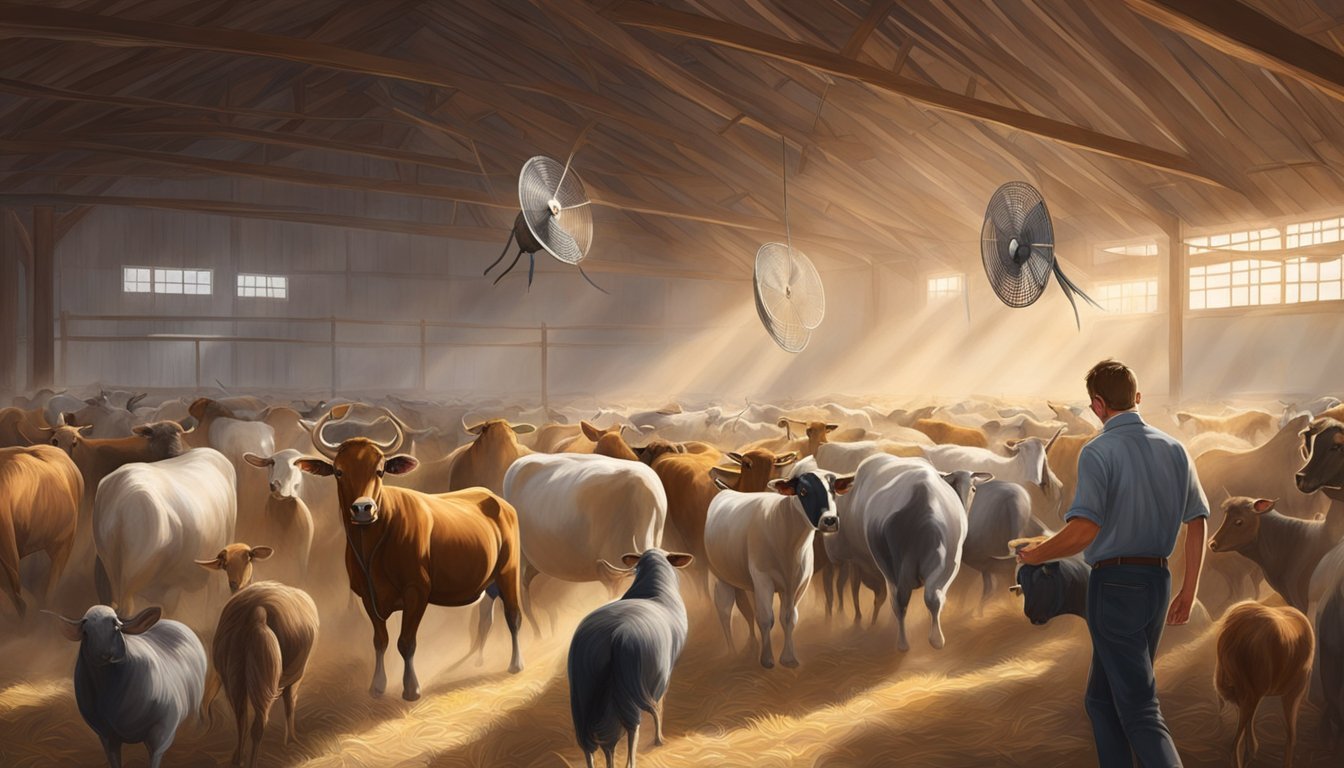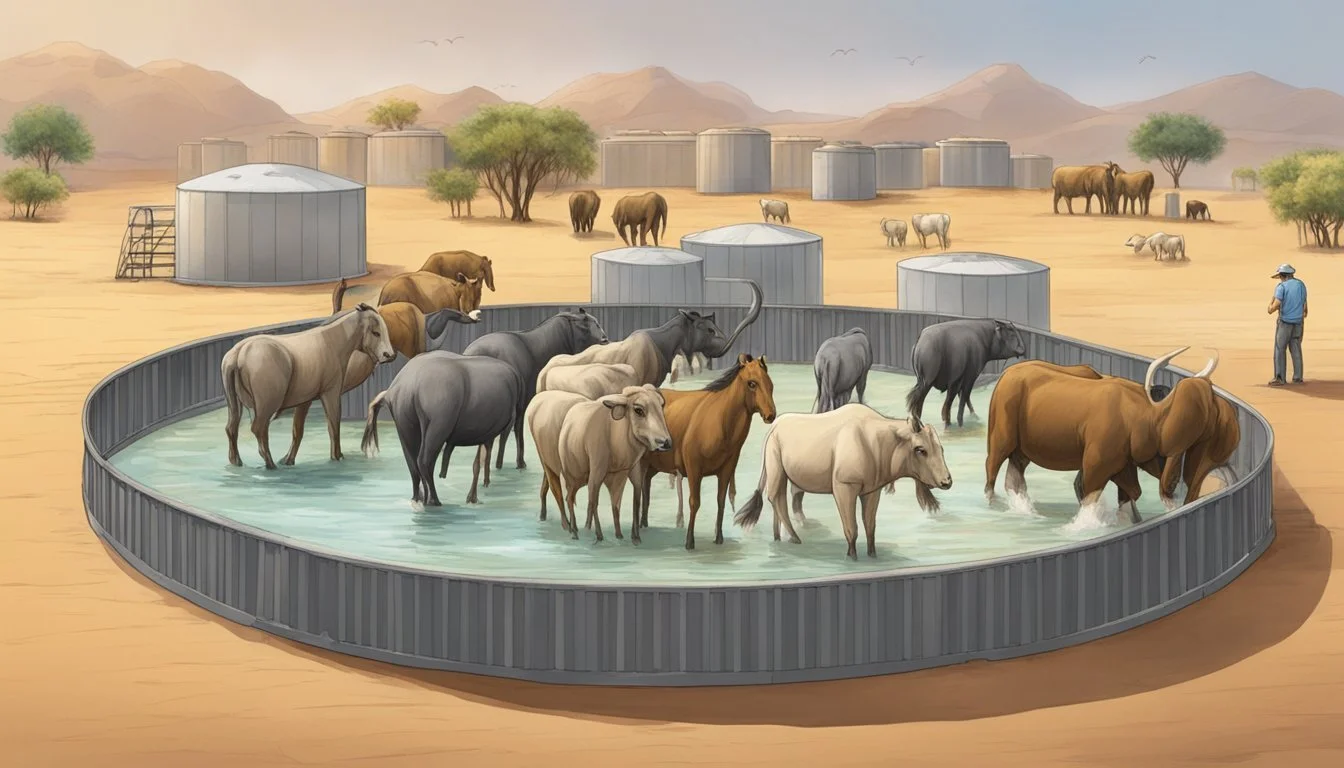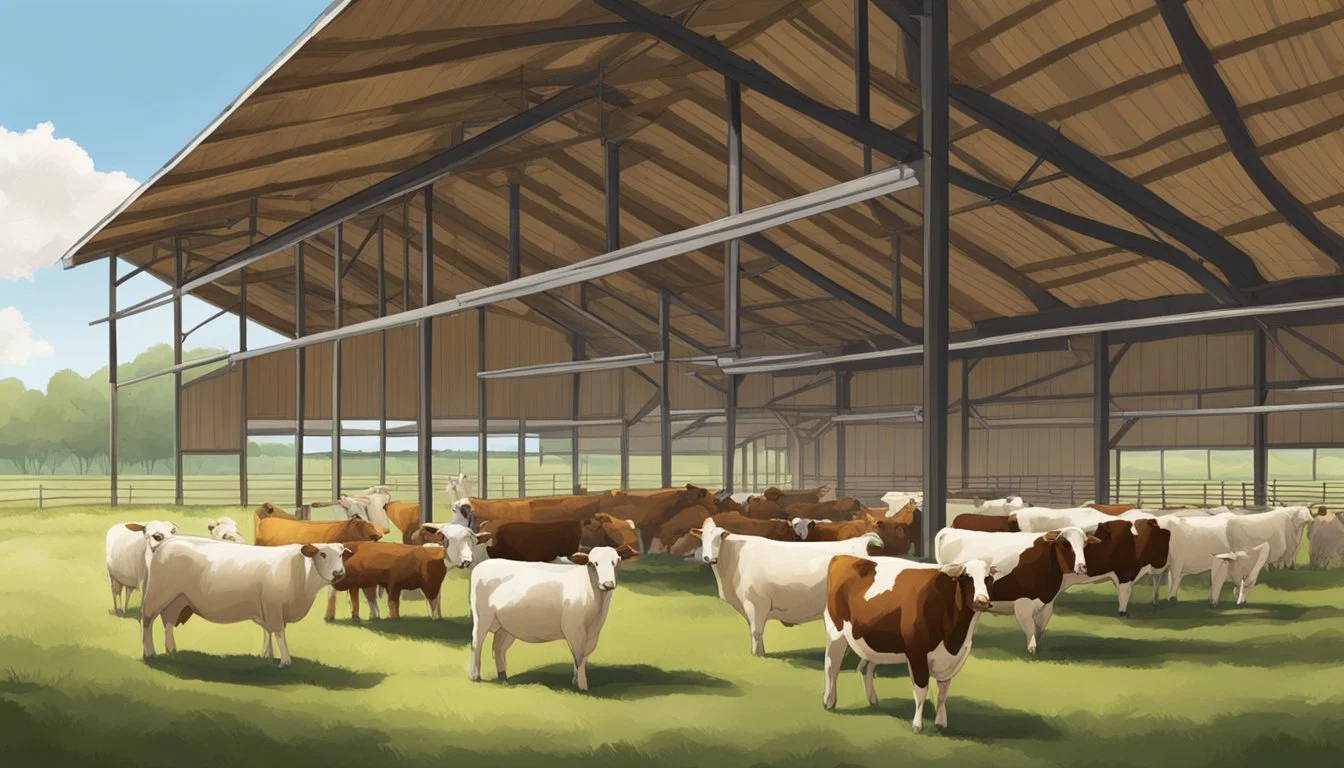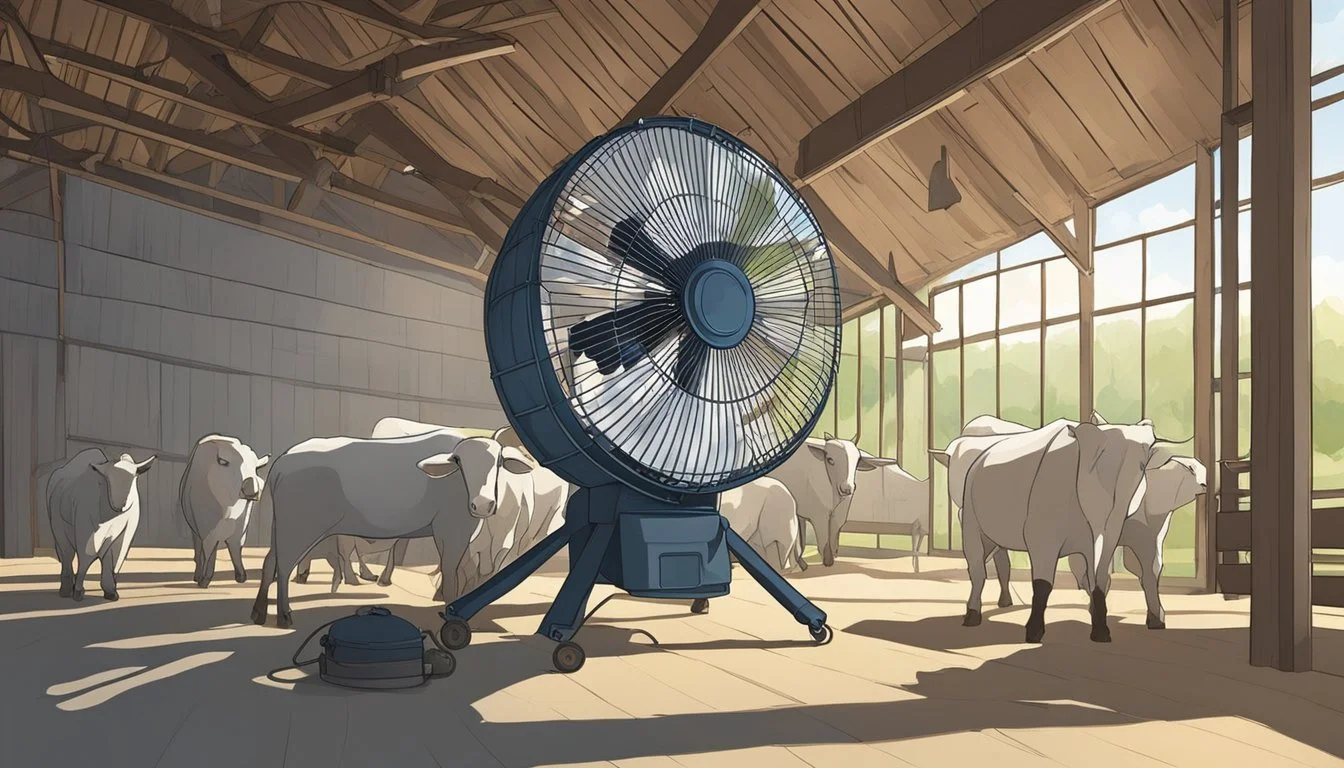The Ultimate Guide to Using Livestock Fans
Strategies for Animal Heat Stress Prevention
As temperatures rise during the hotter months, it becomes a significant concern for livestock owners to ensure their animals remain cool and comfortable. Livestock, much like humans, can suffer from heat stress, which impairs their well-being and productivity. Employing livestock fans is a practical method to mitigate the impact of hot weather on animals. These fans provide necessary air circulation and can be a cornerstone in an effective cooling strategy for a range of animals including cows, pigs, and poultry.
Utilizing livestock fans helps in maintaining a cooler environment by enhancing air movement, which is vital for the thermoregulation of animals. Moreover, when used in conjunction with other cooling practices such as providing shade, access to clean water, and proper ventilation, fans significantly reduce the risk of overheating. Strategic placement and operation of fans can ensure that all animals receive the benefits of a cooler atmosphere, thus preventing the adverse effects of elevated temperatures.
In essence, the use of fans plays a crucial role in safeguarding the health of livestock during extreme heat. A well-implemented cooling system not only contributes to animal comfort but also supports optimal production levels by minimizing the stress caused by heat. Therefore, understanding the proper use and placement of livestock fans is essential for any farmer looking to maintain a healthy and productive herd in hot weather conditions.
Understanding Heat Stress in Livestock
Heat stress in livestock is a significant concern, particularly during the summer months. It can detrimentally affect an animal's health and its ability to perform. Knowledge and early detection are crucial for managing and mitigating the risks associated with heat stress.
The Science of Heat Stress
Heat stress occurs when animals are unable to dissipate body heat efficiently, leading to an increase in core body temperature. This condition is intensified during summer when high temperatures and humidity levels are prevalent. Livestock animals regulate their body temperature through various means such as sweating and panting; however, sustained external heat can overwhelm these mechanisms, causing stress.
Identifying Heat Stress Symptoms
Early identification of heat stress is key to maintaining livestock health. Symptoms include:
Increased respiration rate: Rapid panting is often the first sign.
Behavioral changes: Livestock may exhibit signs of restlessness or lethargy.
Reduced feed intake: Animals tend to eat less during hot weather.
Monitoring these symptoms allows for timely intervention, reducing potential health issues.
Impacts on Livestock Health and Production
Heat stress adversely affects both the health and performance of livestock. Health issues can range from mild discomfort to severe complications, such as heat exhaustion or even heatstroke. Production impacts are notable as well:
Dairy Cattle: Milk production declines as the respiration rate increases.
Meat Cattle: Reduced feed intake can slow growth rates, affecting weight gain.
Maintaining optimal conditions for livestock during hot periods is essential for their welfare and productivity.
Creating a Cooling Strategy
Implementing an effective cooling strategy is crucial in maintaining livestock health and productivity during hot weather. By assessing farm-specific needs and planning for peak heat periods, farmers can ensure their animals remain cool and minimize heat stress.
Assessing Your Farm's Cooling Needs
Each farm has unique cooling requirements based on its livestock type, facility design, and local climate conditions. Farmers should start by evaluating the current shading availability, ventilation systems, and water intake infrastructure. For example, while poultry may need well-ventilated coops with ample airflow, cattle may benefit from the use of high-volume, low-speed (HVLS) fans to circulate air efficiently throughout the barn.
A farm's water systems also play a vital role in keeping livestock cool. An adequate and reliable source of drinking water is essential as animals consume more to regulate body temperature during summer. Additionally, misting systems can aid in reducing barn temperatures when used in conjunction with fans.
Planning for Peak Heat Periods
Preparation for summer's scorching temperatures must involve a strategy tailored for the hottest times of the day and season. Farmers should:
Monitor weather forecasts to anticipate heat waves.
Adjust feeding times to cooler parts of the day to minimize heat generated by digestion.
Increase the frequency of water availability checks, ensuring all animals have constant access to fresh water.
The use of livestock fans is central to cooling plans, but their deployment must be strategic. Fans should be positioned to create a uniform airflow and may need to be adjusted according to where animals congregate during peak heat. Also, it's important to establish protocols for the cleaning and maintenance of fans to ensure they function optimally when needed most.
Implementing Livestock Fans
Implementing livestock fans effectively requires choosing appropriate models, identifying ideal placement for air circulation, and establishing a maintenance routine to ensure longevity and efficiency.
Choosing the Right Fans
When selecting livestock fans, it's critical to consider the size and type of the facility as well as the specific species of animals. For high-ceiling barns, ceiling fans are beneficial since they can circulate large volumes of air and create a comfortable climate without taking up valuable floor space. However, in more compact areas, box or stand fans may be more practical. It is also essential to look for fans with energy-efficient technologies to manage operating costs effectively.
Ceiling Fans: Pros - Large coverage, energy-efficient, Cons - Higher initial installation cost, Recommended for - High-ceiling barns
Box/Stand Fans: Pros - Portable, lower cost, Cons - Limited coverage, may require more units, Recommended for - Smaller or temporary spaces
HVLS (Large Fans): Pros - Wider coverage, low energy consumption, Cons - Requires more space and investment, Recommended for - Dairy barns, large livestock areas
Optimal Fan Placement and Installation
To achieve the best airflow and ventilation, fans must be strategically placed to uniformly distribute fresh air. This includes installing them at a height where they can push warm air down and draw cooler air up, forming a consistent air exchange cycle. Fans should be out of reach of animals to prevent tampering and potential harm. When integrating exhaust fans, positioning them near the roof helps pull out hot air and excess moisture, which is particularly important for efficient heat dissipation.
Above resting areas: Key to increase comfort and reduce heat stress.
Entry points and hallways: Enhances the natural airflow.
Near feeding stations: Can reduce fly presence and improve the feeding environment.
Maintenance and Servicing of Fans
Regular service and maintenance are vital to uphold the performance of livestock fans. This involves scheduled cleanings to remove dust and debris, which can obstruct airflow and diminish efficiency. Additionally, check-ups of the electrical components should be conducted to prevent electrical hazards. Establish a service routine that includes:
Cleaning fan blades and grills.
Inspecting cords and electrical fixtures.
Lubricating motors if necessary.
Ensuring all safety guards are in place and secure.
By staying on top of the maintenance, one can extend the longevity of the fans and ensure they operate at optimal energy efficiency, saving costs in the long run.
Supplemental Cooling Systems
In addition to ventilation fans, supplemental cooling systems such as water misters and shade structures are crucial in reducing heat stress in livestock during hot weather. These systems help to maintain optimal conditions within the barn or holding area, ensuring that animals remain cool, hydrated, and comfortable.
Using Water Misters and Sprays
Misters and spray systems can significantly decrease the temperature in livestock environments. These systems work by releasing a fine mist of water into the air, which evaporates and cools the surrounding area. Farmers should install misters in a way that allows uniform distribution of water across the animals without causing wetness that could lead to other health issues. The droplet size should be small enough to ensure rapid evaporation while providing effective cooling.
Misters: Utilized for moderate to high humidity conditions
Sprays: Best for drier climates where rapid evaporation contributes to cooling
One method of utilizing misters is to integrate them with fans to create an evaporative cooling effect. Misting systems should be used during the hottest parts of the day, and it's essential to provide drainage to avoid excess moisture buildup.
The Role of Shade Structures
Shade structures serve as a barrier to direct sunlight, significantly reducing the temperature for livestock by providing a cool area to rest. Natural or artificial shades can be installed strategically to ensure all animals have access to cool areas throughout the day. When designing a shade structure, airflow should be considered to prevent heat from becoming trapped, thus diminishing the cooling effect.
Points to consider for effective shade structures:
Orientation: Position to block direct sunlight during peak hours
Material: Use reflective materials to deflect sunlight and heat
Height: Construct high enough to allow for proper air circulation
Using both misting systems and shade structures in tandem can create an environment that effectively combats the heat, keeps animals well-hydrated, and minimizes the occurrence of heat-related stress or illnesses.
Managing Water Resources
The ultimate success of keeping livestock cool hinges on diligent water resource management to ensure animals remain hydrated and healthy during hot weather.
Ensuring Adequate Water Supply
It is critical to provide a continuous and reliable water supply to maintain livestock health and productivity. The availability of water directly influences animals' ability to regulate their body temperature and stay cool. A sudden lack of water can lead to rapid dehydration and heat stress, which can be detrimental to an animal's well-being. Farmers should check and maintain all water systems regularly to prevent malfunctions that could disrupt the supply. Additionally, in hot weather:
Capacity: Ensure that the farm's water system has the capacity to meet increased demand during high temperatures.
Back-up Solutions: Have contingency plans such as additional water tanks or mobile water trailers in case of system failure.
Improving Water Intake for Animals
The goal is not just to provide water, but also to encourage adequate consumption to keep the livestock well-hydrated. The following strategies can help:
Water Quality: Clean and fresh drinking water is more appealing and supports higher levels of intake. A regular checking schedule should be in place to test for contaminants that can reduce water palatability and lead to decreased consumption.
Accessibility: Water points should be easily accessible, with multiple watering locations for large herds to prevent crowding and ensure each animal gets its chance to drink.
Feed Considerations: As diets switch or dry matter intake changes, monitor and adjust water availability accordingly. Animals consuming dryer feed mixes or high-fiber diets need more water.
By attending to these specifics, farmers can optimize water management and reduce the risk of heat stress among their livestock.
Feed and Nutrition in High Temperatures
Feed and nutrition are vital in managing livestock health during high temperatures. Proper adjustments to feeding schedules and the addition of specific supplements play a crucial role in maintaining hydration levels and mitigating heat stress.
Adjusting Feed Schedules
Feeding schedules should be tailored to the cooler parts of the day, typically early in the morning or late evening, to reduce the heat load on animals. It's important that they have access to food during these times when their appetite might be naturally higher due to lower temperatures. Consistency in feeding times helps livestock cope with heat stress more effectively.
Supplements and Salt Licks
Supplements:
Fat: Incorporating fat as an energy supplement benefits livestock because it contains high energy density which can be especially useful when feed intake is reduced due to heat.
Electrolytes: The addition of electrolytes can help maintain the animal's electrolyte balance, which can be disrupted by excessive sweating in hot weather.
Salt Licks:
Salt licks provide essential minerals and help promote water intake, which is crucial for keeping the animals hydrated. Always ensure clean water is readily available in conjunction with salt licks.
Livestock Behavior and Comfort
Heat stress significantly impacts livestock behavior and comfort, necessitating proactive measures to ensure they remain cool and comfortable. Recognizing stress indicators and providing a well-ventilated, shaded environment can mitigate adverse effects.
Monitoring Animal Behavior
Livestock exhibit certain behaviors that may indicate heat stress. Observers should watch for signs such as increased respiration rates, open-mouth breathing, and lethargy. Consistent monitoring of these behaviors is crucial for early detection and response.
Key indicators of stress include:
Panting or rapid breathing
Reduced feed intake
Restlessness
A structured monitoring schedule can ensure that livestock are observed during the hottest parts of the day, when they are most at risk for heat stress.
Improving Livestock Comfort
Creating a comfortable environment for livestock during hot weather involves a combination of accessible shade and efficient ventilation. Fans play a pivotal role in maintaining a cool atmosphere in barns and stables.
Strategies to enhance comfort:
Provide ample shade to protect animals from direct sunlight.
Use high-volume low-speed (HVLS) fans to promote air movement and cooling.
Ensure access to clean, fresh water to prevent dehydration.
Fan placement should maximize air circulation to reach all animals. Barns and other animal housing should be designed for effective air exchange, keeping the interior as cool as possible.
Combating Environmental Challenges
Effective management of internal barn conditions is essential to mitigate environmental challenges that affect livestock during hot weather. It involves strategic control of pest populations and maintaining air quality through dust management and ventilation enhancement.
Dealing with Insects and Pests
High temperatures can lead to an increase in insects and pests, such as flies, that are not just a nuisance but can also spread diseases among livestock. Installing livestock fans plays a critical role in keeping these pests at bay. The air flow created by fans is often sufficient to deter flies and other insects, which prefer still air environments to thrive. Moreover, strategic placement of the fans can create an inhospitable environment for pests, consequently contributing to the overall health and comfort of the animals.
Fly Control Strategies:
Fan Placement: Position fans to create consistent air flow across all areas.
Sanitation: Regularly remove waste and damp bedding to discourage pest breeding grounds.
Dust and Air Quality Management
Dust can significantly compromise air quality, exacerbating respiratory issues in livestock and hindering the effectiveness of cooling systems. Implementing fans aids in the reduction of dust levels, while ensuring a cool and breathable environment. The movement of air not only cools the animals but also causes dust particles to settle more quickly, thereby maintaining a cleaner atmosphere within the barn.
Ventilation Improvement Measures:
High-Volume, Low-Speed (HVLS) Fans: These fans circulate large volumes of air at slow speeds to minimize dust suspension.
Regular Cleaning: Routine cleaning of surfaces to prevent dust accumulation.
Specific Cooling Needs for Different Livestock
When dealing with livestock cooling, one size does not fit all. Each species has unique requirements that must be carefully managed to ensure their well-being in high temperatures.
Cooling Systems for Cattle and Cows
Cattle, especially dairy cows, are highly susceptible to heat stress due to their size and metabolic heat production. Adequate shading in pastures and the use of high-velocity livestock fans in barns are critical. These fans improve air circulation and can reduce the temperature significantly in the cow's environment. Misters or sprinkler systems can enhance cooling by evaporation, but the humidity levels need to be monitored to avoid excess moisture that could lead to hoof problems or other health issues.
Water availability: Ensure constant access to cool, fresh water as a cow can drink up to 20 gallons per day in hot weather.
Poultry: Managing Heat in Chicken Coops
Chickens are highly prone to heat stress since they lack sweat glands. Airflow inside coops can be facilitated with fans, and installing vents or opening windows can aid in passive cooling. On extremely hot days, a fine mist should be applied without making the interior of the coop damp as this could promote disease. Providing ample water and electrolyte supplements helps to prevent dehydration.
Coop design: Ensure the coop allows for cross-ventilation and is equipped with fans to promote air movement.
Special Considerations for Goats, Sheep, and Horses
Goats and sheep require less intensive cooling systems but must have access to shade and fresh water. Shearing wooly breeds before the onset of peak summer heat can also aid in keeping body temperatures down. Horses benefit from shade, ventilation in stables, and the option for cool showers. Fans should be securely installed in barns or stables to keep air moving, with dust filters to maintain air quality.
Shelter placement: Position shelters to block late afternoon sun, the hottest part of the day, and ensure they have proper ventilation.
Swine Cooling Techniques
Pigs are particularly vulnerable to heat as they do not sweat. Cooling is usually achieved through wallow pits or misters. Fans help circulate air in enclosed spaces like barns, ensuring respite from the heat. Evaporative cooling pads can lower temperatures effectively in indoor environments. When transporting pigs or taking them to shows, it's essential to provide ventilation and cooling in trailers to prevent heat-related stress or illness.
Water systems: Pigs should have continuous access to water, and in the case of larger operations, automated cooling systems that activate based on temperature can ensure consistent relief from heat.
Leveraging Technology for Enhanced Cooling
As temperatures rise, effective cooling systems are crucial in protecting livestock from heat stress. Technology plays a pivotal role in ensuring animals stay cool through automated systems and energy-efficient solutions.
Automated Cooling and Ventilation Systems
Automated cooling and ventilation systems offer a seamless integration of technology to maintain a comfortable environment for livestock. These systems can detect changes in temperature and humidity, adjusting fans and ventilation settings accordingly to optimize air circulation.
Sensors and Controllers: These devices help maintain the desired climate within livestock facilities, triggering cooling mechanisms like fans and sprinklers when predefined conditions are met.
High Volume, Low Speed (HVLS) Fans: HVLS fans enhance air circulation by moving large volumes of air at slower speeds, proficiently distributing cool air throughout the facility.
Energy Efficiency and Renewable Energy Solutions
Investing in energy-efficient technologies and renewable energy solutions can lead to long-term cost savings and sustainability.
Solar Power: Solar panels can power ventilation systems, making the operation more sustainable and less reliant on traditional energy sources.
Energy-Efficient Fans: Fans with energy-efficient motors and variable speed options consume less electricity while achieving the same cooling effect.
By integrating these technologies with traditional cooling strategies, farmers can create a controlled, ventilated, and energy-saving environment that secures animal welfare during hot weather conditions.
Preparing Livestock for Transport in Hot Climates
When transporting livestock in hot climates, it is critical to mitigate heat stress and ensure the animals arrive at their destination in good health. Appropriate preparation and on-the-road strategies can significantly reduce the risk of stress and heat-related complications.
Pre-Transport Considerations
Ventilation: Before transport, one should confirm the vehicle's ventilation system is fully functional. Adequate air flow is vital in minimizing heat buildup.
Acclimatization: Animals should be gradually acclimatized to the temperatures they will experience during travel.
Hydration: Providing ample water before departure is essential to prevent dehydration. Water stations should be accessible and clean.
Schedule: If possible, plan travel during the cooler hours of the day, such as early morning or late evening.
Health Check: A thorough examination by a veterinarian can confirm the livestock are fit for travel.
On-The-Road Cooling Strategies
Temperature Monitoring: Regularly check the internal temperature of the trailer to ensure it remains within a safe range.
Water Sprays and Misters: Equip the trailer with water sprays or misters to help cool the animals when necessary.
Frequent Stops: Make regular stops to provide water and check on the livestock's condition.
Insulation: Use insulating materials within the trailer to protect against heat from direct sunlight.
Travel Speed: Maintain a steady speed to ensure consistent airflow through the vehicle.
Long-Term Planning for Climate Challenges
To safeguard livestock during hot summer months, long-term planning focuses on optimizing the design of facilities for enhanced airflow and implementing landscaping strategies that create deep shade. These measures are vital for maintaining cool environments in the face of rising temperatures.
Designing Buildings for Better Airflow and Cooling
Ventilation is a critical aspect of building design that directly impacts livestock welfare during heat stress conditions. Structures should ideally be oriented to capture prevailing winds, which enhances airflow naturally. The incorporation of high ceilings and open-sided barns can facilitate the movement of air, while adjustable louvers and ridge vents allow for more fine-tuned ventilation control. Moreover, strategically placing livestock fans can significantly boost air circulation, especially in areas where natural airflow is limited.
Key elements for ventilation:
Orientation to capture winds
High ceilings
Open-sided barns
Louvers and ridge vents
Additional livestock fans for targeted airflow
Landscaping for Livestock Environment
Landscaping can play a substantial role in mitigating heat stress. Planting trees and creating deep shade areas can lower the ambient temperature in pastures, providing a natural and energy-efficient way to keep animals cool. The choice of species is important; trees need to be robust and non-toxic to livestock. Eucalyptus and poplar trees, for instance, are recommended due to their fast growth and dense canopy that creates deep shade. Furthermore, a well-planned paddock layout with access to shade allows livestock to regulate their temperature by seeking shelter when necessary.
Strategies for creating deep shade:
Select robust, fast-growing tree species
Position trees to maximize shaded area
Ensure non-toxicity to animals
Plan paddocks to provide accessible shade
Extra Tips and Best Practices
To maintain the health of livestock during hot weather, consistent care and readiness for temperature spikes are crucial. Employing livestock fans is a beneficial strategy, but additional measures ensure the well-being of the animals.
Routine Care and Monitoring
Scheduled Check-Ups: Farmers should perform daily health checks to spot any signs of heat stress early. This includes monitoring for rapid breathing, lethargy, and reduced feed intake.
Water Availability: Animals need a continuous supply of fresh, cool water. One should check water levels several times a day and replenish as needed to prevent dehydration.
Shade Provision: If natural shade is insufficient, providing additional shelter can help protect livestock from direct sunlight.
Emergency Measures for Extreme Heat
Cooling Stations: Set up designated areas where animals can be misted with water, especially when the temperature soars unexpectedly.
Electrolyte Supplementation: In case of extreme heat, offering electrolytes can help animals recover from heat stress.
Immediate Veterinary Assistance: Promptly contact a veterinarian if an animal shows severe signs of heat-related health issues.
Conclusion
In the height of summer, keeping livestock cool is not just a matter of comfort but a necessity for their health and well-being. Employing livestock fans is an efficient way to maintain a well-ventilated environment for animals such as cattle, pigs, and poultry, ensuring they remain comfortable even during extreme temperatures.
Fans help to circulate air and reduce humidity, which is essential for staying cool and reducing heat stress. They are a key component in a comprehensive strategy that includes:
Adequate hydration: Ensuring constant access to fresh, cool water.
Shade provision: Creating shaded areas where animals can escape the direct heat of the sun.
Strategic scheduling: Limiting the handling and transportation of livestock to cooler parts of the day.
The investment in a proper cooling system, including reliable and efficient fans, should not be overlooked. It safeguards the productivity of the farm by minimizing the risk of heat-related health issues in livestock. The welfare of animals is paramount, and their ability to remain cool is intrinsically linked to their overall health status.
Every farmer should consider integrating fans within their hot weather management practices, as it can make a significant difference in the well-being of their herd. With the correct setup, livestock can thrive through the warmest seasons, maintaining high levels of productivity and health.







